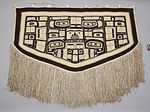Chilkat Robe
About this object
History of use
Weaving blankets from mountain goat wool mixed with shredded cedar bark is an ancient and complex tradition. The techniques were kept alive by the Tlingit, who acquired weaving knowledge through marriage with the Tsimshian. The robes were traded along the coast to be worn on ceremonial occasions by Haida, Tsimshian and Kwakwaka'wakw chiefs. Chilkat robes were symbols of wealth: to own them endowed a chief with prestige. Even greater prestige resulted from giving them away in potlatch. If there was no chief attending of high enough rank to receive it, the blanket might be cut into strips and distributed to a number of persons of prestige. These strips would be made into other ceremonial garments, such as shirts, aprons, leggings, headdresses, or bags. In recent years, weavers from other coastal communities have relearned the techniques, using sheep’s wool with cedar, to produce modern versions for ceremonial use.
Narrative
This robe is said to have belonged to Kaigani chief Edwin Scott (Kasawak). It was passed down through his family and then sold to a dealer (H. Roloff). The previous owner, Diane Anderson, purchased it in 1991 from a curio shop in Victoria, BC. This robe appears to be one of the robes being worn in two c. 1900 photographs taken in Klinkwan, Alaska by Winter and Pond (published in 'Images from the Inside Passage' by Victoria Wyatt (1989: 122–123).
Physical description
Chilkat style robe with woven designs and fringe. The design is in three panels, with an ancestor face in the middle and animal motifs above, below and to the sides. The design is yellow, light blue and dark brown on natural ground. A long twisted fringe of mixed wool and cedar bark hangs from the bottom. Two cotton ties are sewn to the top, along with eight (non-original) cotton twill hanging loops.
Categories
Date Made
C. 1875-1900
Date Acquired
2 Oct 2015
How Acquired
Donated
Credit Line
Measurements
Overall: 134 cm x 160 cm
Object Number
3131/1
